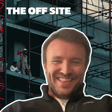Become a Creator today!Start creating today - Share your story with the world!
Start for free
00:00:00
00:00:01

How Projects Balance Productivity & Critical Path Logistically
In this episode of the podcast, Jason and Carlos tackle the challenge of managing productivity from the angle of logistics and resource scheduling. To do this they've enlisted the help of Richard Fifita, CEO of Veyor, a software provider focused on removing the headaches associated with site deliveries and material handling.
The trio discuss which parts of the project require logistical coordination, who the ultimate conductor is when it comes to coordinating the site, and whether it's possible for tech to solve the prioritisation issue on site.
Follow Carlos on Linkedin | Follow Jason on Linkedin | Check out Aphex
Transcript
Introduction and Casual Conversation
00:00:00
Speaker
So, it'll be just like an open, open conversation ah that Olu then cuts up and turns into a, into a podcast episode. Olu, so Olu's going to make me sound good. Okay. Thanks, Olu. Well, he's yet to do it for me. Don't let me down, man. He's yet to do it for me.
00:00:20
Speaker
You're listening to the Offsite Podcast with Jason and Carlos, where we talk all things construction and technology. Join us for discussions with industry leaders and insights into the latest trends in construction.
00:00:34
Speaker
Welcome back to the podcast. Before we dive in, Carlos, mate, how are you? Yeah, all good, thank you. Currently in a chaotic flat where my wife's trying to pack for our first holiday with the ah the two month old.
Impact of UK's New Prime Minister on Construction
00:00:49
Speaker
Okay, you're straight into it. Yeah, we used to share one suitcase and I've got three. So ah yeah, I'll let you know how the flight goes tomorrow. Very good. ah In the UK, have you got a new Prime Minister yet? Or what's the story on the election? Dumb and dusted. now We have a new Prime Minister, it's a formality now. The Tories have to absolutely tank it. Labour are super strong. So yeah, you just have to wait for it to happen now.
00:01:16
Speaker
The obvious question is like a construction software vendor then is like, is that good for construction or bad for construction? i I think it's actually good. There's going to be a huge amount of investment or additional investment in renewables. I wouldn't be surprised if the other half of HS2 suddenly popped up again, because laborer seemed to be more invested in the northern powerhouse ah project. So to make that connection would would make a lot of sense. So yeah. There's nothing like starting a project, stopping a project and restarting a project to make sure you get value for money for it. Yeah, yeah let's ah let's redesign it three times. But as long as you redesign it to a ah cheaper scope, it's fine, right? Yeah, it's like that classic ah meme where it's like what the client wanted,
Richard's Journey from Construction to Software Development
00:02:00
Speaker
what the designer designed. You get this like eventually this tree with like no swing on it. ah Look it up. It's a meme about a tree with a swing.
00:02:08
Speaker
A topic today that we wanted to dive into is something that came up in a series of conversations over a couple of weeks when we were talking about every construction software company and every like article or post on LinkedIn that talks about the construction industry has this like one chart from McKinsey that talks about productivity and construction. There's like there's the like productivity growth of every other industry and there's construction just like basically flat for 20 years. And if you you can't do a slide on construction and you can't make a pitch deck about construction that doesn't have that slide in it, it's like an obligatory slide. We're talking about like what is productivity? It's basically the output per like hour worked from from ah a worker on a construction site.
00:02:53
Speaker
For my dumb brain, that's like super tactically, you could basically visualize that as this idea of keeping resources that are on site busy, producing actual valuable work. And on the flip side of that, so many of the conversations that we have in the space of scheduling, in and planning, in production on a construction site often get drawn into this, like, we've got to get this work done because the master schedule says, and that's what the the critical path of the project is. And it's almost like the flip side of the coin to the concept of productivity, which would be like more around like flow of work and keeping resources busy.
00:03:29
Speaker
And so I wanted to have this conversation in depth around like, is there a balance to be had between the two? What's different between the two? How do projects ah balance those things? And we've got a the perfect guest um to have the conversation with.
Introduction to Vea's Tool for Construction Logistics
00:03:45
Speaker
welcoming to the podcast Richard for feeder. Richard is the CEO of Vea, which is a resource scheduling ah platform. Well, based out of the greatest country in the world in Oz and doing awesome things with ah construction contractors. Richard, thanks for joining us, mate. Great to be here, mate. Thanks for having me on.
00:04:10
Speaker
I do this obligatory like stalkier people's LinkedIn in preparation for the podcast. I knew we'd get on when I saw you. We both worked at John Holland and we both went to the UK and then we both came back from the UK and then started working in software. There's something about going to the UK that says, I don't want to keep working in construction, maybe. Yeah. And also something about it where you say, oh, hey, there's a lot of problems in this industry. We need to get back home and fix the industry, right? We had this idea of like, this idea of like, yeah, we were in ours working on a project going, and there must be a better way to move to the UK. Got on there and go for a moment. Yeah, as I was saying before, like, I've been on construction parts out of Dubai in America. and
00:04:55
Speaker
It's just, you see all the same things, the same processes, same like permit boards, whiteboards for like, you know, planning deliveries and cranes. It's pretty nuts. Like how similar everything is, irrespective of where you go. Yeah, the UK and Australia was actually not too far off each other, I'd say. So as a standards, did you find the same? Yeah, I think what's super interesting with that similarity across so many markets is how different even two companies' processes are, or feels they are. Interestingly, the construction project that I was running was in Vauxhall, and it was actually right on the River Thames. It was called the Corniche. It was called the Corniche. It was actually a high-rise apartment.
00:05:46
Speaker
It's called the the flashy ones. It's like Yeah, yeah nice right yeah so I did the works like the ground foundations and the structure for it. I was actually pretty interesting like engineering wise because you had to you were digging a basement right adjacent to a train line structure. So there was a very much um temporary works and monitoring needed and e etc. But what was even more interesting was catching the train to work early in the morning on a Monday. And so you'd walk past, there'd be like nightclubs, people still queuing up at 7.30 in the morning on a Monday to go into the nightclubs. So you were just walking past all these like interesting characters um every Monday morning. yeah um And then suddenly you got the River Tain and Westminster across the river and everything.
00:06:41
Speaker
um It was definitely an interesting area. It seems to be changing quite a lot now, but that that was an interesting memory. coming Coming from Australia is wild with how how late everything starts in the UK and people get up. like You get up at like yeah five thirty in the morning and it feels like you're walking around a ghost town for four hours and with no one anywhere. Yeah, there was definitely like ah different expectations on like hours. So I was kind of, everyone just thought I was mad that I'd still be in the office at six some days just because I was like, oh I just haven't finished what I was planning to do. And they're like, all right, we go.
00:07:17
Speaker
um But yeah, I think it's probably just an Australian culture, which I don't know if it's the if it's the best way to go about it. I think there's definitely shifts in the way Australian construction inside from now operating. You're trying to move more towards the five day work week and everything, but that's that' a whole other topic. Well, right. I'll pull us back onto topic. And so yeah I guess I'll pick up ah from where we were. And so Richard, like with I guess most of the audience that would typically listen to this podcast being across Oz, UK and the typical audience being construction managers, project managers and
Challenges in Construction Logistics
00:07:56
Speaker
planners.
00:07:56
Speaker
For anyone that hasn't seen or heard or used Viya, do you want to give like the let's say the two-minute overview of of of how of what it does and and how you support projects? yeah Definitely. We're a delivery and material scheduling tool. um What that means is that ah certain the process that we replace is the way engineers, subcontractors and suppliers all schedule their deliveries and materials coming in and out of their sites. So a lot of the time it's just lock the phone calls.
00:08:30
Speaker
um Lots of emails and spreadsheets, and then there's a coordination process at the end of each day where they're looking at what are you prioritizing to to enable those deliveries. So in a high rise construction site, for example, you need the tower crane to be lifting the material up the tower. um and normally I'll have a meeting in front of a whiteboard where everyone is shouting out their requests saying I need 7am, I need 8am but there's always, everyone always wants 7am so um what our system does is that we allow that process to happen by a digital
00:09:05
Speaker
a booking form where people can see what times ah but times haven't been requested yet for the towel cranes or if the delivery zone is own free as well as I can get my trucks in or you might realise there's a concrete pool booked out so the crane can't actually receive any deliveries for the day so they can only do work for internal lifts. So our system helps you schedule and plan all of those different meeting parts with your supply chain um and as well as all your internal crane movements or or logistical movements and so it's very much a coordination and planning tool but at the same time it's about tracking what's arrived on that material, you know what have you got through, how many you know tons of steel reinforcement has arrived so far, how many cubes of concrete have you received so far.
00:09:52
Speaker
the logistics, the deliveries and the material, it's all interlinked obviously. So our system helps you order, plan and coordinate all of that with your supply chain. So so yeah so going back to this ah the the the thing that I kind of started out with, which is this like productivity piece being getting the most output for an hour of work or or an hour of a piece of equipment. How much of of what customers are doing in the in that workflow that you describe is about like utilization of the piece of equipment or the loading. How much of it is literally, you know I need to get steel over here and there's a concrete pour and the crane can't lift.
00:10:38
Speaker
How much of it is like a logistical collaboration thing and how much of it is like an efficiency and productivity piece? Yeah, ah well, I mean, one is the logistical coordination is more in the lead up to the work and then the utilization tracking is once the work is happening. And so on one level, just being able to plan all that work stops unexpected arrivals turning up. A lot of the time When you don't have a clear planning and planning process, a lot of people will turn up at the gate and kind of squeeze in the delivery, say, oh, can you just squeeze in one lift? And that kind of little sounds like not a big deal, but it all just has that follow and effect where the whole schedule starts pushing out. And in high rise construction in particular, a lot of the material is coming in on a just in time basis. There's always workers waiting for that material.
00:11:30
Speaker
start being worked on. So still reinforcement, for example, is probably the best example of that. The skill fixes are all waiting though, there's only so much you can load up at a time. They'll lift off the bottom still and drop that in, they start installing that straight away, but then all the tops still will then come at midday. But if that midday delivery is running late, because it's been held up on another job, the workers can't do anything on on site. And so to your question about utilization. Typically, people don't know where that next delivery is coming. People are just standing around waiting for it at the gate. But what our system does is you know we give that visibility. If a truck's turning up like coming late,
00:12:07
Speaker
your steel supplier can provide that information. You can see you know is somebody else ready to take that request or to use that from that waiting time. And then you can, I guess, stuff all the schedule in real time and let other people come in earlier. So these cranes are so very expensive equipment. yeah You've got several crane riggers and drivers who are usually being contracted out for over $100 per hour. And then in Australia, any time after three o'clock they're being charged at about double time to the GC. So you've got this very expensive labour force and if they're ever standing around doing nothing um it just means that the work that that we're supposed to be doing is going to be getting done at the end of the day when it's even more expensive to do. yeah So and I guess one of the other things that we find is that when you have repeat offenders, when you're able to start recording who keeps coming in late
00:13:04
Speaker
um Who keeps taking longer than they should you're able to record all these non compliances because there's a direct cost to people standing around doing nothing for an hour. So you start to you know get all that compliance. Yeah, I know the poor performers are and so forth. Yeah, I'm immediately having flashbacks to to to different projects, mate, where I'm thinking about, you know, the afternoon before having this, the conversation where a bunch of supervisors are saying, I need to lift the, you know, you know infrastructure job, the bridge girder at 10 o'clock, it's arriving. There's someone else saying, yeah, but the right, can you off load a rebar truck for me, you know, eight o'clock that morning, rebar truck turns up late, then you're screwed on the,
00:13:50
Speaker
go to Lyft and then things just kind of back up up up up through the day and then the thing at the end doesn't doesn't happen. The immediate thoughts obviously were like around crane lifts and scheduling crane lifts. Does that pattern of like logistics and coordination and scheduling happen? Any other parts of the construction process or is it is it is it largely crane-based? With construction, got one of the things an old site manager it just said to me was basically, the crane is the heart of the job.
00:14:23
Speaker
Like if your crane's not doing anything, your side's not doing anything. And I used to have a construction director who would fit by the window because our site office was right and was in a high rise opposite our site. He'd just sit there watching the cranes. And I remember this one time I saw the cranes not doing anything and then I rang my crane coordinator and was like, wait, why is the crane not doing anything? Get a go. Just start looking busy. Go lift things on the other side of the site so it looks like it's working. and why is he because go yeah And like, I mean, like there's nothing worse than like, if a if an an operations manager, or a construction manager walks past the site, and the cranes aren't doing anything, because it just means like, they'll they'll start telling you that you don't need the crane, or they're gonna take the cranes off you.
00:15:08
Speaker
So it just means like for them, you're not planning properly. You're not getting enough work done. um So it's a really bad look in high-rise construction. But to your question on what other plants and equipment would, I guess, indicates progress, um interestingly, the crane is all about how do you get the vertical movement of material up and down efficiently. But the other tools for doing that is also you attempt your hoists, goods lifts we typically find that once the tail cranes get removed everything starts going up the hoists and the goods lift and you need to have like a clear structure for organizing all of that and so we're normally used right through to the end of the project and then your loading dock becomes a bottleneck so for that how efficiently you can feed deliveries and material into the loading dock and then up the goods lift so it's the same concept around efficient vertical movement and so yeah you find that
00:16:03
Speaker
the means of on moving your material up and through the tower painters throughout the course of the project. Whereas my onsite manager, you can say like, yes, it was all like high rise is all about how efficiently you feed the job, the more efficiently you can get the material being fed through. the the better
Coordination and Planning in Construction Projects
00:16:24
Speaker
chance you have of meeting all your program requirements. There's obviously this huge ah coordination piece ultimately. There's obviously a lot of preplanning that you can go into the theory of what is tomorrow and how are we going to sort of schedule everything in. We're dealing with some of the most volatile aspects of construction, which is deliveries that could be late, cranes that could be winded off, etc, etc.
00:16:47
Speaker
Who's the ultimate sort of conductor? And by that I mean, if things are being delayed, is the person in charge just trying to get their day job done? Or are they thinking what what's most critical? how do we How do we sort of sequence this in a way that's actually best for the project, not just to get the the task list complete, if you know what I mean? Yeah it's a good question and like that kind of just indicates like how you're right it is a volatile space because the elements are constantly changing as well which is complicated things further but it is typically your your site manager or general superintendent who will make that call because
00:17:27
Speaker
you know, their job is to make those top calls on who gets prioritized over other people. You know, if you've been winded off and now you can only, now the cranes are operational only for two hours at the back end of the day, everyone's going to be screaming at the site manager, say, hey, ki my lift is more priority than theirs. but you do really need someone that's quite strong-headed. Don't get it off to tell everybody else to piss off, but at the same time understand what's really driving the program. What are the critical lists that's going to help drive Critical Path? So it always goes back to Critical Path and program and I always find the best site managers that I've dealt with.
00:18:07
Speaker
understand that, they understand what's not important and what is important and they'll always make those calls um and they'll push back on everybody else. So I guess that's why they get paid the big bucks because they are tough decisions when everyone's calling you and scraping at you saying that they're more important than the other people but the the general superintendent or the the site manager on a building site would be that person. and And whilst this is all kicking off, how are they actually, how's everyone in the loop? Like, is it, is it actually individual phone calls? Do you have radios? Everyone's sort of listening in. Yeah, it's a disaster. Because like, I had to do this when I was, um yeah, it was, I thought it was the biggest stitch off at the time. Like I had, I got tasked with being a logistics manager on a big high rise project. God, like whenever, like the crane got winded off, or if the crane broke down in the morning,
00:19:01
Speaker
my phone would be just going off, everyone's trying to call me to ask, oh, what you know what's happening with my delivery, like my truck's waiting around the corner, do I send it off, do I keep that? And then I would always then go through the priorities of my site manager about which ones are we gonna keep, which ones we'd bump to tomorrow, and then what which deliveries from the next day that we'd bump to the next day, et cetera. So I guess that's what makes it so difficult, is that you have to you're constantly reprioritizing, But then the other complexity, when you're dealing with like a manual system, under the bra you then need to call every single person and then they normally say back to you, oh actually, I can't do it, I can't do this other time, but then that conflicts with somebody else. And so it's this really crazy process of back and forth phone calls and China sounds like trying to organize going to the pub with four mates. So then you've to like, yes, calls that person and then
00:19:51
Speaker
yeah to Yeah, with four people with kids. That's what it's like. Yeah, that's it. They check their kids schedule. And then I've actually, Amy has a kids party on that day. Can you try this day? It's it's crazy. So it's a process. You said something before, which is really interesting, the idea that like the best person to to make these calls on on priorities is someone that's got this understanding of like i guess the the project schedule, what's critical. The flip side of that is something that we see like a lot from the like planning side, is that there'll be almost the total opposite, which is
00:20:31
Speaker
If you look at the the project through this like sketch master schedule, you end up ah seeing some projects go down this path of really like hyper-prioritizing critical path to the massive detriment of non-critical work. And then the result of that is you just push off all this work that's supposed to be getting done and sacrifice it for the critical path work. And then you end up with this kind of like big bunch of work getting pushed further and further out. And you end up with like this kind of bowel wave effect where eventually that just comes to the head and the schedule blows out massively. Like on one extreme on the schedule, well, you've got this hyper focus on critical path.
00:21:10
Speaker
on on what we were talking about before there's this idea of every day we're trying to get the most work done and so there's like a prioritization of the stuff that is critical. From a product perspective can do you or can you do anything around making people aware of like what is priority or more higher priority in the like coordination of those things or is it or does it have to live in someone's mind? um At the moment it does lose some of mine, but I think if anything, the the utilization data around who is the primary user of the Chrome, what are the primary deliveries coming in and out of the job, actually paints that picture for your prioritizing too much towards structure. And so like, it's funny, we've got these cool dashboards where you actually see
00:21:58
Speaker
the usage by the trade, like, like, there's like a histogram. And at the start, it's basically all structured and the structure starts to go down and facade starts to come in, then fit out, trade starts to come in. And then before you know it, the structures top down and it's predominantly facade. These are the kind of, I guess, patterns and trends that people look out for. So if anything, our system maybe be highlight through the utilization data that you're you're prioritizing one company too much over another. um And let's see your example there in the, what would happen in construction if that that were the case, was that you'll end up having like this massive empty car park with like no facade on it if you just keep prioritizing the structure, right? If a site, if a high rise site is being built in a good way, what normally would be happening is you'll have the top three floors of structure
00:22:53
Speaker
Then below it should be three floors dedicated to the curtain wall facade installation that's happening around the perimeter. The next three floors below that will be maybe, you know, services, trades and so forth, and then fit out trades below. so um the general pattern with like efficient high rise construction is that you have all these trades following each other up the tower
Trends and Workforce Dynamics in Construction Logistics
00:23:17
Speaker
in a cyclical fashion um and that becomes evident like it's cool we see the trends on our dashboards that like it's almost like yes now it was you know you've now reached floor seven where the facade's all there is and the facade started ramping up and if you don't see it
00:23:34
Speaker
you can start asking questions of the issues with the fabrication of the facade make arrived on time. So it can help you detect those, those issues. But what we are finding or what I what a lot of people have said is that a lot of the old timers like your the OGs and construction who know all this stuff inside out around the cycles and how nicely everything should be behind each other, like they're all retiring. And then there seems to be this sort of big gap between the next generation coming through. And I think yeah that is where systems like ours need to try to capture this kind of data to teach the next generation because it's um it's all stuff that gets passed down by word of mouth from one super to another and so forth. And so we can better capture that data. It'll help the next guys.
00:24:25
Speaker
And if I'm like thinking on the spot of like the things that you would want to measure from that and you can tell me whether that's like what people would be measuring. I'd imagine if I'm like ah if i'm if i'm running the facade team or if i'm I'm a sub that's trying to complete a scope that on on the build. There's probably this interesting measure of like how often you're pushing my requested time. So is is that like part of the mechanic? Like I'm asking for seven and repeatedly you're giving it to me at 1pm sort of thing. Is that a thing that people are measuring? Is that, is that, um, is that it? So I wouldn't say the measure, it and sort of measuring it in what respect, like
00:25:03
Speaker
Well, just like I can imagine this i like this this metric where I i can i could visualize this ah dashboard of each of the different teams that might be requesting and the effective kind of like a push rate of like yeah how often or how close on it, which is my my requested time to the time I actually get. Yeah. i Interestingly, it's probably more around the quantum of time provided as opposed to the exact time. And interestingly you start to see patterned form where people start allocating between seven to 10 is all structured trade to to 12 will do the first load of the side deliveries and then you know between three to five will do the second load of the side deliveries and everyone else is like sort of falling in between. So you see this patterned form on sites where
00:25:56
Speaker
It doesn't happen organically. It's more like dictated by the site managers. like We sort of see all these trends where a site manager is saying, I was prioritized structure at the start of the day, then next is the facade, then the next can be yeah finishes and services trades. But what we do do is like we start seeing the total quantum of time that people are requesting, know whether they're generally putting in three hours of requests per day, and then what's actually been approved and and done. You can record the actuals of how many, how long the credit has been allocated to specific trades.
00:26:33
Speaker
Do you tie that to how long it's actually used? Do you record the actual? Yeah, correct. It's a manual input however, so it's either the crane operator or the main crane rigger recording that we started at this time and were finished at this time. super exact but it's indicative that you know that work did happen um and interestingly some of the structural some of the structural steel companies actually start putting they start inserting into their contracts that they have a minimum number of hours of drainage required each week and so our utilization tracking becomes a way to sort of
00:27:16
Speaker
verify that these contractual terms are being met. Again, like that's just, like if that's highlights how critical craniages on a lot of these types of projects. And so if there's a shared tower crane, people are now just starting to make it mandatory or putting it into their contracts that they have five X hours of craniage a week, or, or, or they have reason to like, you know, put in an extension of time and claim. and And then for for folks that are thinking about this, well, yeah, for me thinking about this problem, I started to think about in like different directions, how far does the, what's the like box that you draw around the product? And so I'd imagine you, it goes like out to
00:28:02
Speaker
delivery coordination delivery times there's like a notification or some interaction with the drivers of vehicles so that touches like the suppliers and then there's like vehicle management plans related to that does that kind of yeah come into the picture yeah that's more of our um our infrastructure customers that's more of a feature than they utilize more so we have um like a sitemaps feature where people can, the admins can update the latest VMPs, they'll have a broadcast and they're going to issue out to notify everybody on the access route and change today. Or this gate will be closed as of tomorrow, etc. So from a logistics perspective, communicating all the routes is also a big problem, especially if routes change from time to time.
00:28:48
Speaker
yeah yeah That's another logistical challenge. When I said earlier, that it's all about how how efficiently you feed the job, but then if you keep changing the feeding entry points, that's going to create challenges, right?
Streamlining Infrastructure Projects with Technology
00:29:04
Speaker
so and then Also, if the way you enter those access points has specific requirements, again, that sort you know if some of a new access point only you know goes to a bridge of a certain head height limit, that's the kind of critical information that needs to be relayed across to people. so
00:29:23
Speaker
um yeah yeah the The extent of effort, and I'm reflecting on a project that Carlos and I worked on on on Crossrail ah years ago, the amount of effort and um and manual coordination with yeah vehicle travel routes, scheduling, staging of the vehicles, communicating, and understanding where the drivers are at. There are whole teams of people just doing that. and um Yeah, I'd imagine that's a that's a ah massive service.
00:29:56
Speaker
It's a massive value add for infrastructure projects, the staging, the tracking of the vehicles, the traffic management plans. Carlos, that's something that you see. I know there's an incumbent product in the UK. Does that sound like a similar scope of related things? Yeah. As soon as you said that, I remember going on site on Crossrail. and you go on and it wouldn't match the logistics plan that you had and when you asked if you're like, why weren't you in your suit here at seven a.m. for the briefing when we actually went through the the plan for today and you're not looking at something old? Yeah, so logistics planning is quite a big one because particularly with the London jobs, it's so congested that they have to they read they literally re-plan logistically every day. So it's not like a pedestrian ah like walkway or a material handling area that's like
00:30:55
Speaker
that's there for a week or a month. Seems to be changing every 24 hours. yeah And there's not really any good tools that are like managing that well, communicating it well, and making sure that everyone is in the loop to make it as efficient as possible. Yeah, it's it's been more, it's been more of our infrastructure customers that have been pushing that. And so, yeah, which is why we started heading down towards that. Because it and that was what I was saying before about high rise construction in general, there's been dynamic with yeah the access route to the dynamic and how affect how efficiently you communicate that with everybody is, is quite quite a crucial crucial component of the the productivity on this infrastructure jobs.
00:31:38
Speaker
Yeah, for sure. If we think about performance, yeah ah you mentioned that you track, like, we can track how much Ukraine was utilized over a shift. ah We can track, like, how late deliveries were. How much of this information, and I'd assume probably more than that information, goes back into, like, ah refining or improving the, like, the logistic strategy of a project?
Data-Driven Logistics Strategies
00:32:00
Speaker
Or is it very much, like, gut feel, this isn't going too well at the moment, so let's try something else tomorrow? No, it's a good point. no it's um i I would say the corrections are required are based on gut feel by the approver, the approval but yeah know thats logistics manager or or whoever it is. um so For example, an engineer might be bringing in 20 times of the steel reinforcement going to the top of the tower and he's
00:32:29
Speaker
he might have put in a booking request for an hour. But then you know someone like a crane rigger or a logistics manager should be able to look at that booking request, see that it's 20 tons and there's a bin full of steel bundles and so forth. And they can work out, actually, there's six lifts here. They're going to take about 20 minutes each. I'm going to extend that to an extra half an hour, an extra hour. So just through those adjustments that they make, really what ends up happening is that the people requesting la starts to learn that i actually that's how much I need to be requesting. That's typically how long it takes to complete that tile. So it's almost like a passively learning offer. ah We should actually be trying to capture that data in a better way, like to to say, oh yeah, 20 tons,
00:33:21
Speaker
going up 20 floors should actually quite be longer than that. We just haven't had a chance to get into making all these smart suggestions. That makes sense. But yeah yeah, there's definitely like lots of Like that data is actually helping people better understand. um And then everybody also seeing what everyone else is requesting. What's been really cool, and I didn't know i didn't expect when we started, when we created a product approach was that everyone actually starts holding each other accountable. um People will see that, you know, they're booked in for nine o'clock. If someone else comes in and tries to squeeze in, they go up to them with the app and say, look, you know, I'm the um the next one in, you're not approved, et cetera.
00:34:04
Speaker
and
Fostering Accountability and Collaboration with Vea's Tool
00:34:05
Speaker
So what we find is that subcontractors start holding each other accountable and say, look, you better get there early because I don't want you to push my time out for my delivery. Yeah, it's that right it' a shared responsibility. yeah Exactly. It says like that Academy of like accountability of we're making commitments in front of each other and to each other that this is where we're going to do this. And and no one wants to be the one that lets the I guess the team the team down. I think that visibility is an accountability is super important um our concept that I think would be making a big impact. Yeah, definitely. And interestingly, um
00:34:40
Speaker
It seems to be something that they do more in um America. um You guys are probably probably actually up your alley, but the whole last planner, like, because we're more in the now that we're on a lot more sides of the US and we go out to different side offices, we see those big ass whiteboards and post-it loads and I just like the fact that they actually get around each other and say, yes, you're basically committing to each other that you'll finish that cost by that day for the next month and come in. And it's in a nice simple format. You know, when you get to that stage, you can give each other of shit if someone hasn't or like they'll make a bit more of an effort because
00:35:20
Speaker
you You know, it's ah it's a different thing when someone has dumped a Gantt chart on you. um Yeah, that transparency and everyone being able to see what everyone's planning and knowing who's going to impact who actually creates a much more collaborative work site. And then people start coordinating and having these conversations prior to these meetings where they come up with an agreement. And interestingly, we saw that on our system. we would sometimes see like an overlapping booking and then I'd click in on the overlapping booking and that subby had put in a comment and said, oh yep, I spoke with the other trade and we agreed to share the loading zone and I'm bringing in a smaller truck.
00:36:02
Speaker
So yeah, that whole coordination is pretty awesome. It's like the, yeah, the same as old superintendent used to, to say is if you want people to, uh, if you want people to play like a team, give them a scoreboard. And so yeah, there's that like shared buy-in we're making where we're accountable for it. So. but i'm I'm conscious of time. I so i think we'll we'll still we'll wrap it up there and I want to thank you for taking the time. It was a super enjoyable conversation. Carlos, thank you, Richard. Thank you. and yeah We'll see you all next week. Thanks, Richard.



















